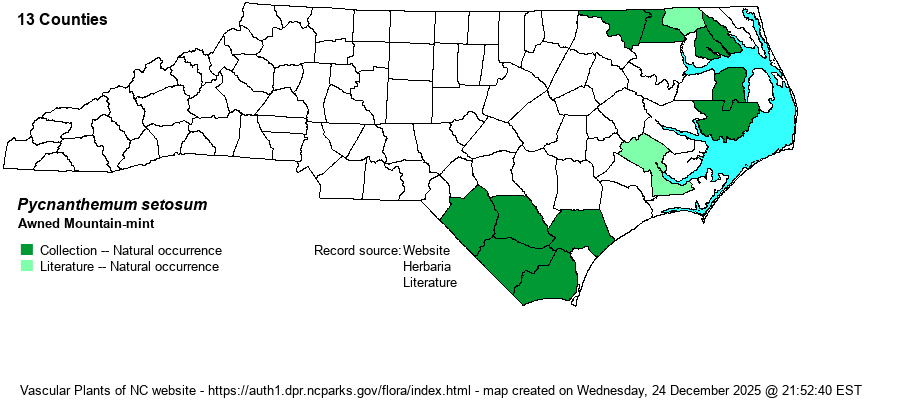| Author | Nuttall | |
| Distribution | Scattered in the Coastal Plain (only), concentrated mostly in the northern portion near the VA line, and also in the far southern counties. A handful of other records, near the coast.
This species is limited to the lower Coastal Plain, from NJ to northern FL, and barely west to MS. It is a relatively scarce species. Not only is it scarce, but there seems to be conflicting information about it among references. | |
| Abundance | Rare to perhaps locally uncommon. This is a Significantly Rare species, and the NCNHP gives it a State Rank of S1S2. | |
| Habitat | Weakley (2024) says "Loamy pine savannas, other dry to moist pinelands, hammocks, river bars, tidal swamps." Thus, it is a wetland species, but of quite divergent habitats. | |
| Phenology | Blooms rather early for the genus, from mid-June to August, and fruits from August to October. | |
| Identification | This species is a typical mountain-mint, being about 2-3 feet tall, freely branched in the upper portions of the stem, and with numerous pairs of opposite leaves. The leaves tend to be ovate, nearly sessile, toothed along the margin, and about 2-3 inches long and half as wide. These species have rather flat-topped heads of about 1-2 inches wide at the ends of each branch, subtended by bracts, with the flowers being very small and generally white with some purple spots on the lower lip. This species has somewhat fewer heads in bloom over the plant than most others, though they are scattered and not close together in a flat-topped inflorescence as in P. flexuosum. It has wider leaves than that common species, also. From P. muticum, it can be separated by calyx lobes that are attenuated into a subulate (extremely narrow) tip, versus calyx lobes triangular to acute but not subulate; this may require a hand lens to see well. To find this species, you may have to use your hand lens and be prepared to collect a plant or at least a few twigs. | |
| Taxonomic Comments | None
| |
| Other Common Name(s) | None | |
| State Rank | S1S2 | |
| Global Rank | G4 | |
| State Status | SR-T | |
| US Status | | |
| USACE-agcp | FACU link |
| USACE-emp | FACU link |

